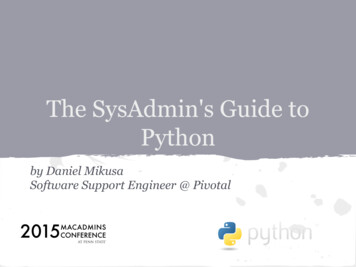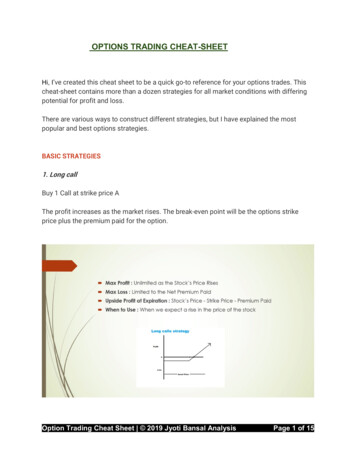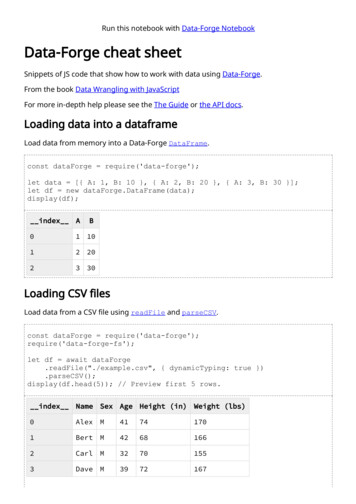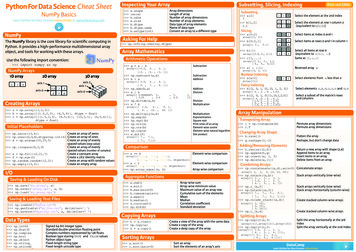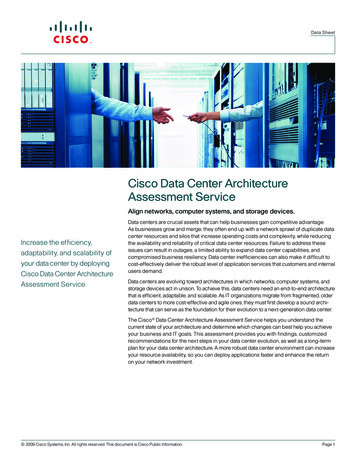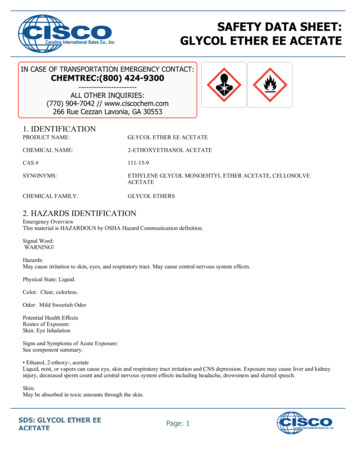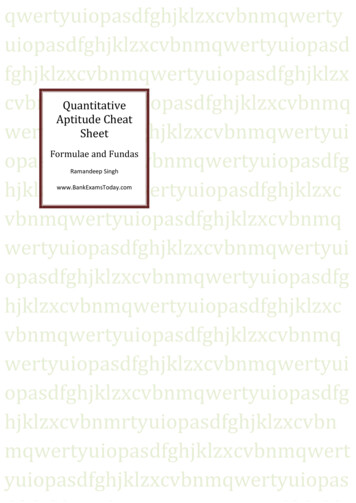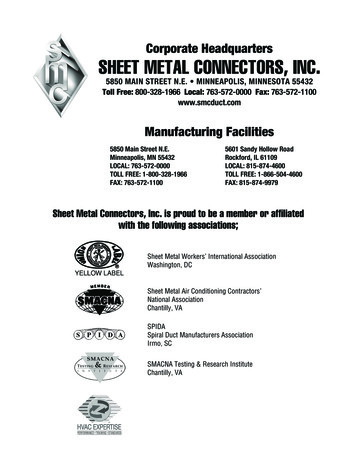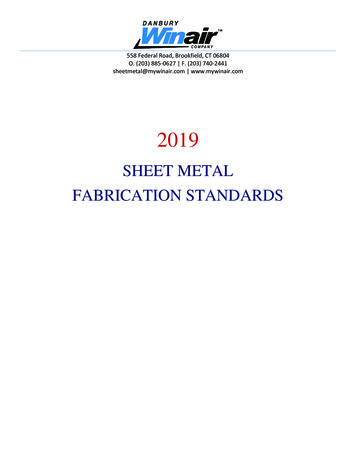
Transcription
SysAdmin Cheet Sheetas compiled by Eddie JacksonKCCThe KCC is a built-in process that runs on all domain controllers and generates replication topology for the ActiveDirectory forest. The KCC creates separate replication topologies depending on whether replication is occurringwithin a site (intrasite) or between sites (intersite). The KCC also dynamically adjusts the topology to accommodatenew domain controllers, domain controllers moved to and from sites, changing costs and schedules, and domaincontrollers that are temporarily unavailable.How do you view replication properties for AD?By using Active Directory Replication Monitor.Start– Run– ReplmonWhat are sites? What are they used for?One or more well-connected (highly reliable and fast) TCP/IP subnets. A site allows administrators to configure ActiveDirectory access and replication topology to take advantage of the physical network.Name some OU design considerations?OU design requires balancing requirements for delegating administrative rights – independent of Group Policy needs– and the need to scope the application of Group Policy. The following OU design recommendations addressdelegation and scope issues:Applying Group Policy An OU is the lowest-level Active Directory container to which you can assign Group Policysettings. Delegating administrative authority usually don‘t go more than 3 OU levelsWhat are FMSO Roles? List them.Fsmo roles are server roles in a ForestThere are five types of FSMO roles1-Schema master2-Domain naming master3-Rid master4-PDC Emulator5-Infrastructure masterLogical Diagram of Active Directory? What is the difference between child domain & additional domainServer?Well, if you know what a domain is then you have half the answer. Say you have the domain Microsoft.com. NowMicrosoft has a server named server1 in that domain, which happens to the parent domain. So its FQDN isserver1.microsoft.com. If you add an additional domain server and name it server2, then its FQDN isserver2.microsoft.com.Now Microsoft is big so it has offices in Europe and Asia. So they make child domains for them and their FQDNwould look like this: europe.microsoft.com & asia.microsoft.com. Now let‘s say each of them have a server in thosechild domains named server1. Their FQDN would then look like this: server1.europe.microsoft.com &server1.asia.microsoft.com.What are Active Directory Groups?Groups are containers that contain user and computer objects within them as members. When security permissionsare set for a group in the Access Control List on a resource, all members of that group receive those permissions.Domain Groups enable centralized administration in a domain. All domain groups are created on a domain controller.In a domain, Active Directory provides support for different types of groups and group scopes. The group type111/3/2011SysAdmin Cheet Sheet.doc v1Software Packaging Engineer
SysAdmin Cheet Sheetas compiled by Eddie Jacksondetermines the type of task that you manage with the group. The group scope determines whether the group canhave members from multiple domains or a single domain.Group Types* Security groups: Use Security groups for granting permissions to gain access to resources. Sending an e-mailmessage to a group sends the message to all members of the group. Therefore security groups share the capabilitiesof distribution groups.* Distribution groups: Distribution groups are used for sending e-main messages to groups of users. You cannotgrant permissions to security groups. Even though security groups have all the capabilities of distribution groups,distribution groups still requires, because some applications can only read distribution groups.Group ScopesGroup scope normally describe which type of users should be clubbed together in a way which is easy for thereadministration. Therefore, in domain, groups play an important part. One group can be a member of other group(s)which is normally known as Group nesting. One or more groups can be member of any group in the entire domain(s)within a forest.* Domain Local Group: Use this scope to grant permissions to domain resources that are located in the samedomain in which you created the domain local group. Domain local groups can exist in all mixed, native and interimfunctional level of domains and forests. Domain local group memberships are not limited as you can add members asuser accounts, universal and global groups from any domain. Just to remember, nesting cannot be done in domainlocal group. A domain local group will not be a member of another Domain Local or any other groups in the samedomain.* Global Group: Users with similar function can be grouped under global scope and can be given permission toaccess a resource (like a printer or shared folder and files) available in local or another domain in same forest. To sayin simple words, Global groups can be used to grant permissions to gain access to resources which are located inany domain but in a single forest as their memberships are limited. User accounts and global groups can be addedonly from the domain in which global group is created. Nesting is possible in Global groups within other groups asyou can add a global group into another global group from any domain. Finally to provide permission to domainspecific resources (like printers and published folder), they can be members of a Domain Local group. Global groupsexist in all mixed, native and interim functional level of domains and forests.* Universal Group Scope: these groups are precisely used for email distribution and can be granted access toresources in all trusted domain as these groups can only be used as a security principal (security group type) in awindows 2000 native or windows server 2003 domain functional level domain. Universal group memberships are notlimited like global groups. All domain user accounts and groups can be a member of universal group. Universalgroups can be nested under a global or Domain Local group in any domain.What are the types of backup? Explain each?IncrementalA ―normal‖ incremental backup will only back up files that have been changed since the last backup of any type. Thisprovides the quickest means of backup, since it only makes copies of files that have not yet been backed up. Forinstance, following our full backup on Friday, Monday‘s tape will contain only those files changed since Friday.Tuesday‘s tape contains only those files changed since Monday, and so on. The downside to this is obviously that inorder to perform a full restore, you need to restore the last full backup first, followed by each of the subsequent211/3/2011SysAdmin Cheet Sheet.doc v1Software Packaging Engineer
SysAdmin Cheet Sheetas compiled by Eddie Jacksonincremental backups to the present day in the correct order. Should any one of these backup copies be damaged(particularly the full backup), the restore will be incomplete.DifferentialA cumulative backup of all changes made after the last full backup. The advantage to this is the quicker recoverytime, requiring only a full backup and the latest differential backup to restore the system. The disadvantage is that foreach day elapsed since the last full backup; more data needs to be backed up, especially if a majority of the data hasbeen changed.What is the SYSVOL folder?The Windows Server 2003 System Volume (SYSVOL) is a collection of folders and reparse points in the file systemsthat exist on each domain controller in a domain. SYSVOL provides a standard location to store important elementsof Group Policy objects (GPOs) and scripts so that the File Replication service (FRS) can distribute them to otherdomain controllers within that domain.You can go to SYSVOL folder by typing: %systemroot%/sysvolWhat is the ISTG Who has that role by default?The first server in the site becomes the ISTG for the site, the domain controller holding this role may not necessarilyalso be a bridgehead server.What is the order in which GPOs are applied?Local, Site, Domain, OU1. Can a workstation computer be configured to browse the Internet and yet NOT have a default gateway?If we are using public IP address, we can browse the internet. If it is having an intranet address a gateway is neededas a router or firewall to communicate with internet.2. What is CIDR?CIDR (Classless Inter-Domain Routing, sometimes known as supernetting) is a way to allocate and specify theInternet addresses used in inter-domain routing more flexibly than with the original system of Internet Protocol (IP)address classes. As a result, the number of available Internet addresses has been greatly increased. CIDR is nowthe routing system used by virtually all gateway hosts on the Internet‘s backbone network. The Internet‘s regulatingauthorities now expect every Internet service provider (ISP) to use it for routing.3. What is DHCP? What are the benefits and drawbacks of using it?DHCP is Dynamic Host Configuration Protocol. In a networked environment it is a method to assign an ‗address‘ to acomputer when it boots up.AdvantagesAll the IP configuration information gets automatically configured for your client machine by the DHCP server.311/3/2011SysAdmin Cheet Sheet.doc v1Software Packaging Engineer
SysAdmin Cheet Sheetas compiled by Eddie JacksonIf you move your client machine to a different subnet, the client will send out its discover message at boot time andwork as usual. However, when you first boot up there you will not be able to get back the IP address you had at yourprevious location regardless of how little time has passed.DisadvantageYour machine name does not change when you get a new IP address. The DNS (Domain Name System) name isassociated with your IP address and therefore does change. This only presents a problem if other clients try toaccess your machine by its DNS name.4. How do you manually create SRV records in DNS?To create SRV records in DNS do below steps: Open DNSClick on Zone —– Select domain abc.local ——Right Click to domain and go to Other New Records——And choose service location (SRV)5. Name 3 benefits of using AD-integrated zones.Benefits as followsa. you can give easy name resolution to your clients.b. By creating AD- integrated zone you can also trace hacker and spammer by creating reverse zone.c. AD integrated zoned all for incremental zone transfers which on transfer changes and not the entire zone. Thisreduces zone transfer traffic.d. AD Integrated zones support both secure and dynamic updates.e. AD integrated zones are stored as part of the active directory and support domain-wide or forest-wide replicationthrough application partitions in AD.6. How do I clear the DNS cache on the DNS server?Go to cmd prompt and type ―ipconfig/flushdns‖ without quotes7. What is NAT?NAT (Network Address Translation) is a technique for preserving scarce Internet IP addresses. For more details go toMicrosoft link8. How do you configure NAT on Windows 2003?411/3/2011SysAdmin Cheet Sheet.doc v1Software Packaging Engineer
SysAdmin Cheet Sheetas compiled by Eddie JacksonConfigure NAT9. How to configure special ports to allow inbound connections?a. Click Start, Administrative Tools, and then click Routing and Remote Access to open the Routing and RemoteAccess management console.b. Locate the interface that you want to configure.c. Right-click the interface and then select Properties from the shortcut menu.d. Click the Special Ports tab.e. Under Protocol, select TCP or UDP and then click the Add button.f. Enter the port number of the incoming traffic in Incoming Port.g. Select On This Address Pool Entry, and provide the public IP address of the incoming traffic.h. Enter the port number of the private network resource in Outgoing Port.i. Enter the private network resource‘s private IP address in Private Address.j. Click OK.DNS Interview Questions and Answer1. Secure services in your network require reverse name resolution to make it more difficult to launch successfulattacks against the services. To set this up, you configure a reverse lookup zone and proceed to add records.Which record types do you need to create?2. What is the main purpose of a DNS server?3. SOA records must be included in every zone. What are they used for?4. By default, if the name is not found in the cache or local hosts file, what is the first step the client takes toresolve the FQDN name into an IP address?5. What is the main purpose of SRV records?6. Before installing your first domain controller in the network, you installed a DNS server and created a zone,naming it as you would name your AD domain. However, after the installation of the domain controller, youare unable to locate infrastructure SRV records anywhere in the zone. What is the most likely cause of thisfailure?7. Which of the following conditions must be satisfied to configure dynamic DNS updates for legacy clients?8. At some point during the name resolution process, the requesting party received authoritative reply. Whichfurther actions are likely to be taken after this reply?9. Your company uses ten domain controllers, three of which are also used as DNS servers. You have onecompanywide AD-integrated zone, which contains several thousand resource records. This zone also allowsdynamic updates, and it is critical to keep this zone up-to-date.Replication between domain controllers takes up a significant amount of bandwidth. You are looking to cutbandwidth usage for the purpose of replication. What should you do?511/3/2011SysAdmin Cheet Sheet.doc v1Software Packaging Engineer
SysAdmin Cheet Sheetas compiled by Eddie Jackson10. You are administering a network connected to the Internet. Your users complain that everything is slow.Preliminary research of the problem indicates that it takes a considerable amount of time to resolve names ofresources on the Internet. What is the most likely reason for this?Answers .1. PTR Records2. DNS servers are used to resolve FQDN hostnames into IP addresses and vice versa3. SOA records contain a TTL value, used by default in all resource records in the zone. SOA records containthe e-mail address of the person who is responsible for maintaining the zone. SOA records contain the currentserial number of the zone, which is used in zone transfers.4. Performs a recursive search through the primary DNS server based on the network interface configuration5. SRV records are used in locating hosts that provide certain network services.6. The zone you created was not configured to allow dynamic updates. The local interface on the DNS serverwas not configured to allow dynamic updates.7. The zone to be used for dynamic updates must be configured to allow dynamic updates. The DHCP servermust support, and be configured to allow, dynamic updates for legacy clients.8. After receiving the authoritative reply, the resolution process is effectively over.9. Change the replication scope to all DNS servers in the domain.10. DNS servers are not caching replies. Local client computers are not caching replies The cache.dns filemay have been corrupted on the server.What is DHCP’s purpose?DHCP‘s purpose is to enable individual computers on an IP network to extract their configurations from a server (the‗DHCP server‘) or servers, in particular, servers that have no exact information about the individual computers untilthey request the information. The overall purpose of this is to reduce the work necessary to administer a large IPnetwork. The most significant piece of information distributed in this manner is the IP address.What protocol and port does DHCP use?DHCP, like BOOTP runs over UDP, utilizing ports 67 and 68.What is Global Catalog? The Global Catalog authenticates network user logons and fields inquiries about objectsacross a forest or tree. Every domain has at least one GC that is hosted on a domain controller. In Windows 2000,there was typically one GC on every site in order to prevent user logon failures across the network.What is Stub Zone in DNS Server?A stub zone is a copy of a zone that contains only those resource records necessary to identify the authoritativeDomain Name System (DNS) servers for that zone. A stub zone is used to resolve names between separate DNSnamespaces. This type of resolution may be necessary when a corporate merger requires that the DNS servers fortwo separate DNS namespaces resolve names for clients in both namespaces.611/3/2011SysAdmin Cheet Sheet.doc v1Software Packaging Engineer
SysAdmin Cheet Sheetas compiled by Eddie JacksonA stub zone consists of: The start of authority (SOA) resource record, name server (NS) resource records, and the glue A resourcerecords for the delegated zone.The IP address of one or more master servers that can be used to update the stub zone.The master servers for a stub zone are one or more DNS servers authoritative for the child zone, usually the DNSserver hosting the primary zone for the delegated domain name.Where is the file of Active Directory data file stored?Active Directory data store in %SystemRoot%\ntds\NTDS.DIT. The ntds.dit file is the heart of Active Directoryincluding user accountsWhat are the types of records in DNS?To see the records of DNS Server checks this path - DNS RecordsWhat is DHCP and at which port DHCP work?Dynamic Host Configuration Protocol (DHCP) is a network protocol that enables a server to automatically assign anIP address to a computer from a defined range of numbers (i.e., a scope) configured for a given network. DHCPassigns an IP address when a system is startedDHCP client uses port 67 and the DHCP server uses port 68.What is DORA process in DHCP and How it works?DHCP (D)iscoverDHCP (O)fferDHCP (R)equestDHCP (A)cknowledge1) Client makes a UDP Broadcast to the server about the DHCP discovery.2) DHCP offers to the client.3) In response to the offer Client requests the server.4) Server responds all the IP Add/mask/gty/dns/wins info along with the acknowledgement packet.711/3/2011SysAdmin Cheet Sheet.doc v1Software Packaging Engineer
SysAdmin Cheet Sheetas compiled by Eddie JacksonWhat is Super Scope in DHCP?A superscope allows a DHCP server to provide leases from more than one scope to clients on a single physicalnetwork. Before you can create a superscope, you must use DHCP Manager to define all scopes to be included inthe superscope. Scopes added to a superscope are called member scopes. Superscopes can resolve DHCP serviceissues in several different ways; these issues include situations in which: Support is needed for DHCP clients on a single physical network segment—such as a single Ethernet LANsegment—where multiple logical IP networks are used. When more than one logical IP network is used on aphysical network, these configurations are also known as multinets.The available address pool for a currently active scope is nearly depleted and more computers need to beadded to the physical network segment.Clients need to be migrated to a new scope.Support is needed for DHCP clients on the other side of BOOTP relay agents, where the network on the otherside of the relay agent has multiple logical subnets on one physical network. For more information, see―Supporting BOOTP Clients‖ later in this chapter.A standard network with one DHCP server on a single physical subnet is limited to leasing addresses toclients on the physical subnet.What is Stub zone DNS?A stub zone is a copy of a zone that contains only those resource records necessary to identify the authoritativeDomain Name System (DNS) servers for that zone. A stub zone is used to resolve names between separate DNSnamespaces. This type of resolution may be necessary when a corporate merger requires that the DNS servers fortwo separate DNS namespaces resolve names for clients in both namespaces.A stub zone consists of: The start of authority (SOA) resource record, name server (NS) resource records, and the glue A resourcerecords for the delegated zone.The IP address of one or more master servers that can be used to update the stu
Applying Group Policy An OU is the lowest-level Active Directory container to which you can assign Group Policy settings. Delegating administrative authority usually don‘t go more than 3 OU levels What are FMSO Roles? List them. Fsmo roles are server roles in a Forest There are five t
